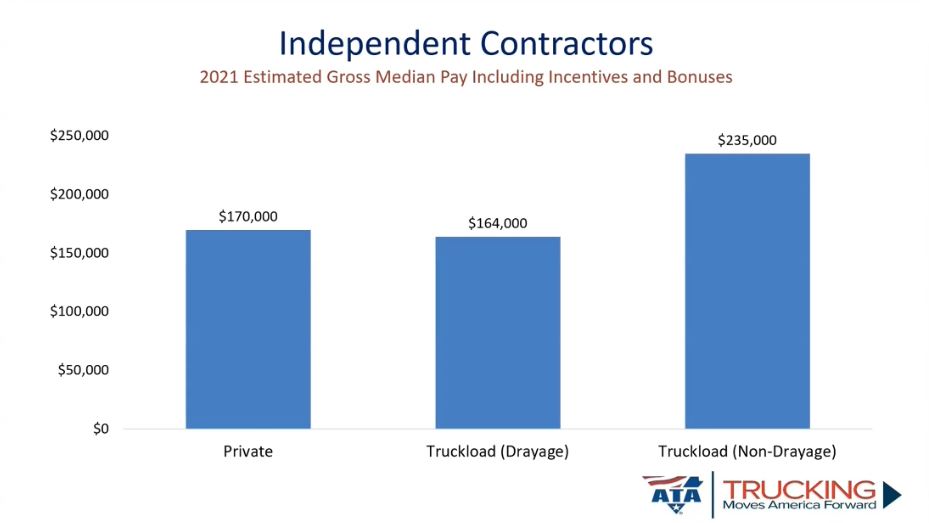Truck driver compensation webinar misses the mark
Recently, the National Academy of Sciences and the Transportation Research Board held a meeting on truck driver compensation. Unfortunately, it was full of misinformation.
During the open session of the truck driver compensation meeting, representatives from the American Trucking Associations and Women in Trucking gave presentations to stakeholders. The WIT presentation was more of a 30-minute infomercial rather than a presentation about driver compensation. However, ATA chief economist and Senior Vice President Bob Costello brought up some controversial points, including lowering the minimum age required to obtain a CDL.
Costello mentioned that the median age of an employee driver is about 50 years old, which is well above the median age of 42 for all workers in the United States. He added that the average student at a truck driving school is in their 30s. Costello also mentioned that several countries in Europe have lowered the age to drive truck to 18.
Under-21 drivers will lower truck driver compensation
Bringing up the minimum age to drive truck during a truck driver compensation presentation seems like an odd move considering that lowering the age can drive down wages, not increase them.
If the average age of a student driver is in fact in their 30s, then those entering the industry are likely at a point in their life when they need to earn a higher wage. These are men and women who are more likely to have a family to take care of. Those who don’t have a college degree may find trucking a viable choice to earn a decent wage.
Conversely, someone who is just right out of high school does not demand such a higher wage. Many, perhaps most, 18- or 19-year-olds don’t have a family they need to feed. Rather, they are just entering the workforce and trying to figure out what to do with their lives. Employers know this. That is why entry-level jobs that do not require a college degree have relatively low wages.
Speaking of relatively low wages, the median pay for heavy and tractor-trailer truck drivers is $48,310 per year or $23.23 per hour, according to the U.S. Bureau of Labor Statistics. Comparatively, the median weekly earnings of full-time workers in the U.S. were $1,085 in the fourth quarter of 2022, which comes to a little over $56,000 a year. That is the real problem.
There is no driver shortage. Rather, there is a shortage of those in their 30s on up who are willing to work for less than the nation’s median wage.
Large carriers are aware of this, which is why they want to hire younger drivers – i.e., the younger the driver, the less pay they require. There are not too many jobs an 18 year old can get that will earn them $48,000 a year.
The federal minimum wage is $7.25 per hour. State minimum wages range from $7.25 in 20 states to $16.10 in Washington, D.C. Those are the wages businesses, including motor carriers, are competing with when hiring a teenager. Offer an 18 year old $20 an hour to drive around the country, and you will probably get many takers. A wage of $42,000 is attractive to someone who just graduated high school, but it is not a sufficient amount of money for these 30-somethings that are enrolling in truck driving schools.
What will lowering the age to obtain an interstate CDL do to the median wage of a truck driver? It will put downward pressure on truck driver compensation.
Hiring teenagers is not going to solve the driver turnover rate. Rather, it will exacerbate it. How many older adults are holding the same job they did when they were 18? What are these 18-year-olds going to do when they realize finding a mate and starting a family is going to be really difficult when you are on the road most of the time?
Let’s not forget about insurance policies. Which direction will insurance rates go for a fleet that hires under-21 drivers?
Pay them and they will come
If we want to solve this so-called “driver shortage” problem, all we need to do is increase truck driver compensation. Surprisingly, that was never brought up during the driver compensation webinar.
Groups like ATA will be quick to point out that truck driver compensation is in the six figures. Look no further than the below graph presented by ATA during the driver compensation webinar.

Unfortunately, those numbers are grossly misrepresented. The Owner-Operator Independent Drivers Association calculated the median net income of an owner-operator to be $50,000, which is far less than the numbers represented in the above graph.
If drivers were making six figures, then there wouldn’t be a need for a truck driver compensation webinar.
In March 2019, the U.S. Bureau of Labor Statistics found that the evidence does not support the theory of a labor shortage within the trucking industry and that increasing wages could alleviate any issues with recruitment and retention.
“As a whole, the market for truck drivers appears to work as well as any other blue-collar labor market, and, while it tends to be ‘tight,’ it imposes no constraints on entry into (or exit from) the occupation,” the report states. “There is thus no reason to think that, given sufficient time, driver supply should fail to respond to price signals in the standard way.”
Fast forward four years later, and we are still talking about driver shortages and truck driver compensation. LL









